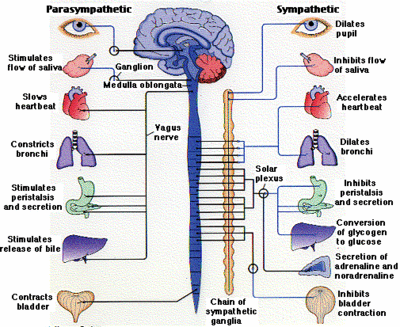Vagus nerve: Difference between revisions
>Oskykins No edit summary |
>Oskykins No edit summary |
||
| Line 1: | Line 1: | ||
[[File:autonomic.gif|thumb|400px|right|Diagram of vagus nerve and effects on PNS and autonomic ganglia via Acetylcholine, right side shows effects of acetylcholine inhibition mediated through the Vagus nerve]] | [[File:autonomic.gif|thumb|400px|right|Diagram of vagus nerve and effects on PNS and autonomic ganglia via Acetylcholine, right side shows effects of acetylcholine inhibition mediated through the Vagus nerve]] | ||
The '''Vagus nerve''' also called '''pneumogastric nerve''' or '''cranial nerve X''' is the tenth of twelve (excluding CN0) paired cranial nerves. The Vagus nerve is one of the primary mediators of the [[neurotransmitter]] [[acetylcholine]] throughout the body. The Vagus nerve connects from the brain stem to the bladder and transports acetylcholine to most of the bodies primary facilities, resulting in an inhibitory effect which slows heartrate, stimulates saliva, constricts bronchi and contracts the bladder stimulating urinary flow, among other functions. | The '''Vagus nerve''' (also called '''pneumogastric nerve''' or '''cranial nerve X''') is the tenth of twelve (excluding CN0) paired cranial nerves. The Vagus nerve is one of the primary mediators of the [[neurotransmitter]] [[acetylcholine]] throughout the body. The Vagus nerve connects from the brain stem to the bladder and transports acetylcholine to most of the bodies primary facilities, resulting in an inhibitory effect which slows heartrate, stimulates saliva, constricts bronchi and contracts the bladder stimulating urinary flow, among other functions. | ||
As well as serving as an output to the various organs in the body, the vagus nerve conveys sensory information about the state of the body's organs to the central nervous system through [[acetylcholine]]. 80-90% of the nerve fibers in the vagus nerve are afferent (sensory) nerves communicating the state of the viscera to the brain. When acetylcholine is inhibited through [[deliriants|anticholinergic]] drugs, the concentration of acetylcholine in the vagus nerve decreases, leading to the commonly experienced physical dysphoria on [[deliriants]]. | As well as serving as an output to the various organs in the body, the vagus nerve conveys sensory information about the state of the body's organs to the central nervous system through [[acetylcholine]]. 80-90% of the nerve fibers in the vagus nerve are afferent (sensory) nerves communicating the state of the viscera to the brain. When acetylcholine is inhibited through [[deliriants|anticholinergic]] drugs, the concentration of acetylcholine in the vagus nerve decreases, leading to the commonly experienced physical dysphoria on [[deliriants]]. | ||
Revision as of 10:21, 12 August 2014

The Vagus nerve (also called pneumogastric nerve or cranial nerve X) is the tenth of twelve (excluding CN0) paired cranial nerves. The Vagus nerve is one of the primary mediators of the neurotransmitter acetylcholine throughout the body. The Vagus nerve connects from the brain stem to the bladder and transports acetylcholine to most of the bodies primary facilities, resulting in an inhibitory effect which slows heartrate, stimulates saliva, constricts bronchi and contracts the bladder stimulating urinary flow, among other functions.
As well as serving as an output to the various organs in the body, the vagus nerve conveys sensory information about the state of the body's organs to the central nervous system through acetylcholine. 80-90% of the nerve fibers in the vagus nerve are afferent (sensory) nerves communicating the state of the viscera to the brain. When acetylcholine is inhibited through anticholinergic drugs, the concentration of acetylcholine in the vagus nerve decreases, leading to the commonly experienced physical dysphoria on deliriants.